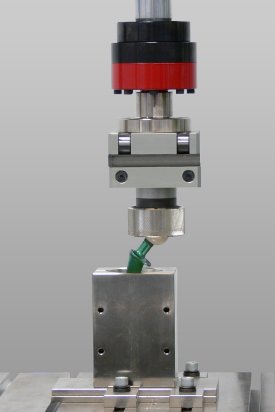Jan 30 2008
The human hip has to carry about 2.5 times the body weight of most full-grown humans for many decades. The hip joint has been optimized by nature for such a permanent stress with about 160 million cycles of alternating load. These forces and strains consist of the body weight and the stabilizing muscles. Arthritis, obesity, osteoporosis, as well as extreme sport activities can have considerably negative consequences for this high-performance design.

The manufacturers of joint endoprostheses know that the choice of the right system for a patient is influenced by many factors, such as the extend of the disease, age, gender, osseous substance, and material tolerance. Nowadays, manufacturers offer various prostheses with different methods of fixation as well as geometries, and made of diverse materials.
Reclassification according to the EU directive 94/42/EEC
The EU maintains control over the variety of joint endoprostheses through directives and standards. The standard regulations and guidelines contain a section for mechanical quality control. Components and total systems are tested for static and dynamic fatigue in order to warrant the product safety and quality over the life of the prostheses.
Due to the current reclassification of hip endoprostheses according to the EU directive 94/42/EEC from Class 2b to Class 3, European manufacturers are required to subsequently submit those test results for joint prostheses already in use to the notified bodies. The compliance to the higher requirements of Class 3 needs to be demonstrated in order to maintain the CE certification for older endoprostheses.
Testing new developments
Of course, testing is also necessary to verify the parameters of newly developed endoprostheses. The parameters and characteristics of the new geometries and materials must be known before the endoprostheses can be implanted in-vivo.
Zwick offers the manufacturers a choice of solutions for the dynamic and static in-vitro testing of hip endoprostheses and their components both in research as well as in production. Apart from testing systems for various static applications, the servo-hydraulic Zwick HC 10 testing machine has been designed and continuously developed for the dynamic endurance test according to ISO 7206.
Testing endurance according to ISO 7206
The dynamic stress at the shaft of the prosthetic hip joint during walking is simulated with the Zwick HC 10. Through axial alternating loads on the shaft of the prosthetic hip joint, the endurance of the shaft over its lifetime of about 10 years is being tested. A simulation with 10 million cycles reflects an average stress on the prosthesis of about 1 to 2 million steps per year with a maximum of 2.3 kN (about 230 kg) over a total period of five years.
The standard specifies that the test is performed with a maximum frequency of 30 Hz. The test cylinder itself is designed with frequencies of up to 100 Hz, which can be set according to further applications.
Ergonomic advantage
Laboratories are often limited in space and require minimum noise levels. Zwick has integrated the low noise hydraulic power pack, with a sound level less than 60 dBA, into the base of the testing machine.
As a result customers save space and additionally, the user can place the machine directly next to the workplace without requiring any additional noise control.
Another new feature is the differential bearing which is mounted directly onto the testing actuator. This lateral differential bearing compensates the lateral movements between the femoral ball and the acetabular cup of the hip joint during gait simulation. This ensures the correct physiological position of the femoral stem to the acetabular cup and also the precise axial measurement without any shear force distortion.
Tension-torsion simulation
In order to further accommodate the physiological conditions of a hip joint, Zwick offers an additional torsion axis for the test according to ISO 7206-08. The additional testing actuator enables superimposed compression and torsion stress on the hip joint allowing different movement sequences and stress scenarios of the hip joint to be simulated.
In-vivo simulation in Zwick temperature bath
Zwick also provides an ambient bath with a temperature unit for the in-vivo simulation, so that users can carry out tests in a saline solution at about 37° C according to typical physiological conditions.
FDA requirements
The software testXpert® II for the dynamic testing with the HC10 has also been developed specifically according to the customer requirements and now offers a powerful user administration system.
Every user logs into the system similarly to the Microsoft® user administration and then various options are shown according to the pre-defined profiles, which have been set up by the system administrator.
Changes to the software settings before, during, or after the test are documented and archived tamper-proof rendering the test data.
All parameters concerning “who-when-what-why” are saved and the processes are documented according to FDA 21 CFR Part 11 in the most secure and traceable way.